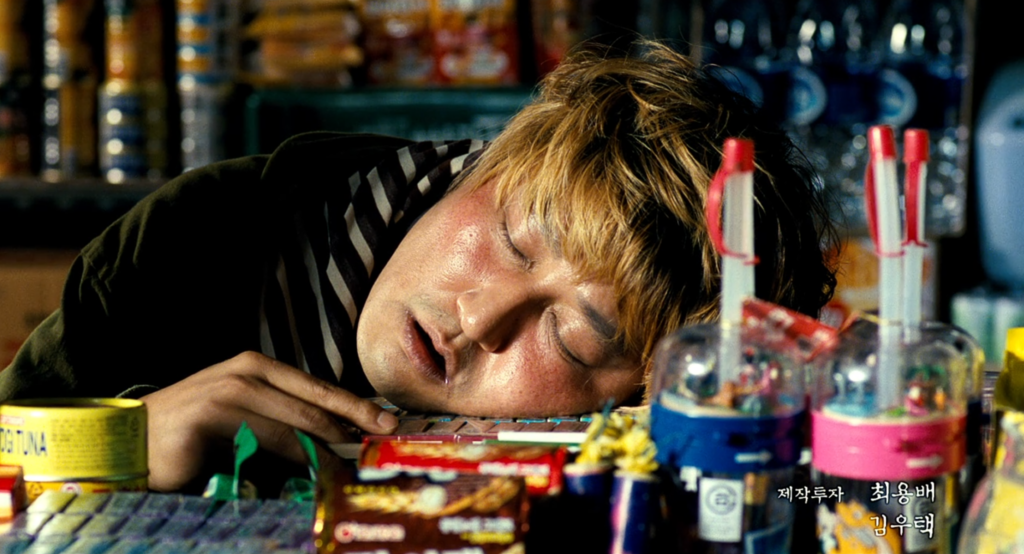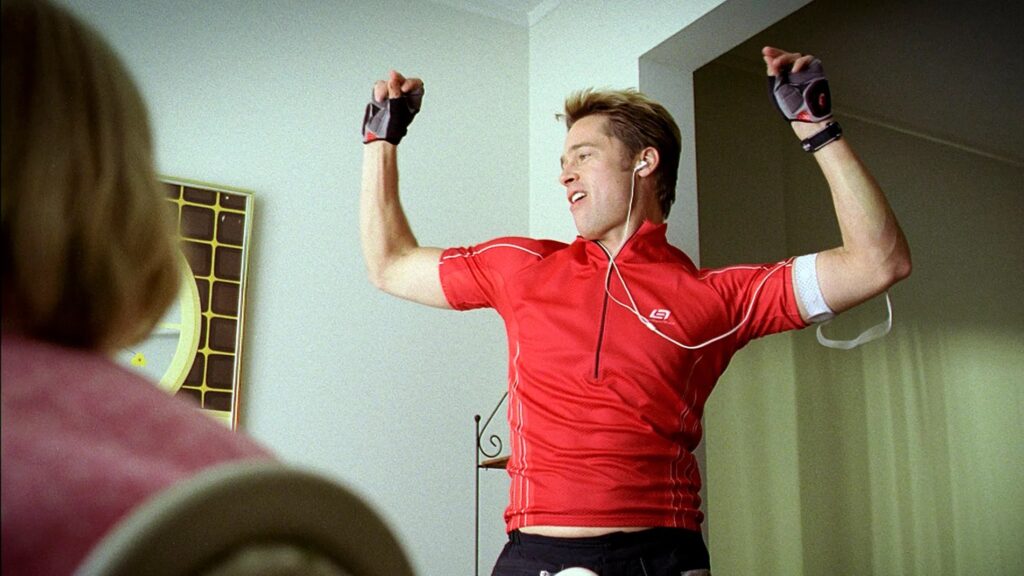|Doug Carmody|

The Host plays at the Trylon Cinema from Sunday, October 6th, through Tuesday, October 8th. Visit trylon.org for tickets and more information.
Bong Joon-ho’s The Host opens to scenes of tension and tragedy. First, in a politically overt sequence, an American doctor forces a Korean doctor to dump formaldehyde into the watershed of the Han River, which bisects Seoul. Second, soaring violins accompany the image of a white collar worker jumping to his death. As the violins subside, the audience perceives a closeup of a food cart cashier, asleep on the job, a pile of quarters stuck to his cheek. The man’s father inquires, “how much sleep can a body take?” One wonders, perhaps, if our comic relief has arrived. Luckily for us, Director Bong has other ideas.
The narrative actually centers on the coin-faced character in question (Park Gang-du, played by the genius Song Kang-ho). Song carries the film, rollercoaster-like, between tragic and comic tones in the space of an instant. This tonal uncertainty was coming into vogue in mid-2000s Korean cinema,1 and the resulting off-kilter vibe proved wildly popular for The Host, which was the top grossing Korean movie of all time until 2014. The tonal slippage also proves fertile terrain for Bong Joon-ho to develop a unique type of protagonist, one that he uses to push the limits of audience empathy.
Hollywood’s Sense of Humor
American blockbusters primarily deploy comedy as an interruption to an essentially serious narrative rather than a core tonality in itself.
Star-driven blockbusters of the 1980s illustrate this structure. As overstuffed with masculine tension as these movies were, their producers understood that the audience would need scripted moments of comic relief. Hence the conversion of sculpted foreigners (Schwarzenegger, Van Damme) and oddly mannered natives (Stallone, Seagal) into stiff sounding boards during moments of levity. Picture the Terminator driving down the highway while John Connor inducts him into the world of teenaged Angelino slang. These moments are structurally necessary to the entertainment, but they have little bearing on the direction of the story or the characterization of its heroes. They mostly operate as rest stops between critical plot beats.
The Marvel era’s injection of self-referentiality into these asides only serves to heighten their dissonance with the deeply sincere narratives they inhabit. These “they fly now”-isms serve to arrest the narrative of the films they occupy and engage the audience in a metacommentary on intellectual property lore. But the movies always get right back to the story, which heads steadfastly to the ultrasincere—both self-conscious Ironman and sour-faced Batman end up sacrificing themselves to save the world at the end.
Comedy Without Relief
Much of popular Korean cinema operates with an entirely different tonal architecture. Pablo Utin diagnoses this architecture as “the slippery structure”:
When compared to other strategies of genre mixing, The Slippery Structure that characterizes the South Korean films discussed in this paper stands out in its abrupt shifts of genre and tone—which take place without suitable preparation and without preserving the tonal consistency of the film. As a result, there is an unexpected change in the nature of the film, leading to an instability, discomfort and disorientation regarding the attitude of the film towards its own subject matter and towards the spectator.2
In other words, the tonal changes of The Host operate not as pauses in the forward propulsion of the plot, but rather as sharp changes in the direction of the film itself. The approach results in productively off-kilter cinema, in which films can produce moments of comedy without sacrificing an ounce of narrative tension, and moments of tragedy without descending into dourness.
The emergence of the monster, perhaps the signature scene of The Host, perfectly illustrates this tendency. The scene begins with a mass casualty event that is mostly played for laughs, featuring bleach blond Gang-du, sporting comically baggy sweatpants and a gangly, stumbling demeanor trying to kill the monster with a traffic sign (he is joined in this endeavor by an American character who somehow looks even stupider than him). The tone slides towards sincerity when his daughter emerges from the food stand and Gang-du takes her hand in order to guide her away from danger. He stumbles again, and as he picks himself and his child off the ground, a menacing orchestral arrangement kicks onto the soundtrack. The camera waveringly tracks from Gang-du back to the child he has rescued, revealing that she is actually not his daughter. The music cuts out entirely while, in a wide shot, the child’s actual father collects her from Gang-du. At this moment, the tone of the scene is ambivalent. Will this be another gag or will it be horrifying? The shot pulls towards Gang-du’s face, which points the way, curdling from astonishment to abject terror. The monster then yanks his daughter towards her death.

These moments emblematize the instability of comedy in popular Korean cinema. Rather than offering relief, levity in these films is never far from souring into bleakness. In fact, Park Chan-wook’s Joint Security Area (2000), the highest grossing Korean movie prior to the release of The Host, climaxes with a moment of charming North-South camaraderie that slips into an internecine bloodbath.
This tonal fluidity also runs in the opposite direction, with genuine tragedy giving way with marked rapidity to slapstick.3 Immediately following the daughter’s abduction in The Host, Gang-du’s family engages in some (mildly performative) grieving at an impromptu memorial site. Shortly after her drunk uncle arrives, bearing harsh criticism of Gang-du’s parenting, their grief escalates into a familial wrestling match, replete with a trademark Bong Joon-ho dropkick (performed, remarkably, from a kneeling position).
The parodic nature of the scene makes it difficult to know which (if any) of the characters to empathize with – should we pity Gang-du or condemn his oafishness? Per Utin, the tonal slippage in this scene and others effects a “moral disorientation”: “it is difficult to pinpoint what the film’s and its spectator’s moral position towards the material is supposed to be.”4
Bong’s Fool
The question of Gang-du occupies the core of The Host’s moral logic—his incompetence being an established fact, the characters surrounding him agitate over whether his failure to protect his daughter should be condemned.
Gang-du’s father poses the question directly: “is Gang-du really so pathetic?” His siblings respond in the affirmative, but for the audience the question remains open—while ineffective, Gang-du was one of the only onlookers to try to save anyone from the monster. Our ability to invest in the narrative hinges precisely on whether we can find the dignity in a character who remains, through the closing moments of the film, hopelessly goofy.
Given this context, it’s unsurprising that various anglophone critics misread the film as centering “a pathetic layabout who must redeem himself,” or more charitably, “a soulful dimwit who stumbles and bumbles on the path to redemption […] Bong’s idea of a Korean Harrison Ford.” Both articles presume that The Host concerns the redemption of its foolish protagonists, despite the film quite explicitly posing the question of whether such redemption is necessary in the first place.
This reading is especially perplexing because the redemption arc it identifies does not actually seem to be in the film. While the Parks do eventually best the monster, they primarily do so by leaning into the more slapstick aspects of their characterization—the brother leverages his alcoholism in concert with his past as a student protestor to lob Molotov cocktails at the creature, the sister uses her archery skills (admittedly not hesitating to shoot this time), and Gang-du himself stabs the monster with yet another traffic sign. They demonstrate grit in the sequence, but without any of the establishing scenes of growth or self-reflection typically demanded within a redemption narrative.
Hollywood’s Fools
The need to redeem, of course, is a difficult habit for Hollywood to kick. In our national cinema, every down and out bum is just a Rocky waiting to pull it together. It’s an odd frame to impose on Bong Joon-ho, who is obsessed with people who are truly worn out and the social processes that wore them out – in Gang-du’s case, being malnourished and forced to beg in childhood.
Even the Coen brothers, who traffic in (Bongian) unredeemed fools, do not afford them very much dignity. If the Coens have recourse against the oft-levied accusations of misanthropy, it lies in the fact that their moral framework engenders sympathy in the context of a universal lack of human dignity. Any loathing towards Brad Pitt’s oafish cyclist in Burn After Reading can be disregarded, since it would have to come from someone like John Malkovich’s ex-intelligence memoirist (who is just another variety of fool).

Much of the entertainment value in the Coens’ filmography lies in the degree of abasement they demand from their stars—seeing George Clooney or Brad Pitt stripped of their usual guile is its own form of entertainment. But this sort of relativistic approach to sympathy does not seem to be what Bong Joon-ho has in mind for Gang-du.
Rather, Bong demands that Gang-du be dignified (or not!) entirely on his own terms. Because The Host never strays far from making light of Gang-du, the film, much like his father, demands that the question of his dignity is never far from his folly.
What to Make of Gang-du
In the end, the film leans on one of Director Bong’s favorite cinematic tricks: Gang-du’s dignity is upheld, in spite of his foolishness and the film’s schizoid tone, by the unparalleled charisma of Song Kang-ho. In contrast to the shambling abjection that the Coen brothers demand from their stars, Director Bong never asks Song Kang-ho to dial back his charismatic megawattage.
Behind his ridiculous hair and bumbling demeanor, Song can’t help but radiate a certain soft dignity in each frame he occupies. As an actor he is uniquely suited to embody and unify the tonal fractures demanded by New Korean Cinema. Director Bong returns to the well quite often, having leaned on Song to import this dignity to an awful cop (Memories of Murder), a barely-verbal druggie (Snowpiercer), and a scammer (Parasite)—in each case flitting between slapstick physicality and deeply empathetic subtlety.
Bong goes so far as to suggest that having Song in his corner allows him to take more risks in the screenwriting process: “when I write a script knowing that [Song] will play the protagonist, no matter what the dialogue is or what the situations are I become bolder as a writer and I feel more comfortable with scenes that I think may be risky.” Song’s unique screen presence then helps to anchor the slippery structure throughout Bong’s filmography.
Gang-du fits neatly in this greater artistic project—one that insists on the enduring dignity of certain characters despite their innate ridiculousness, and despite whatever tragedies might be foisted on them by their social circumstance.
- Pablo Utin, “Sliding through Genres: The Slippery Structure in South Korean Films” Journal of Japanese and Korean Cinema 8.1 (2016): 45–58. ↩︎
- Utin, 49. ↩︎
- Utin, 54. ↩︎
- Utin, 52. ↩︎
Edited by Olga Tchepikova-Treon
